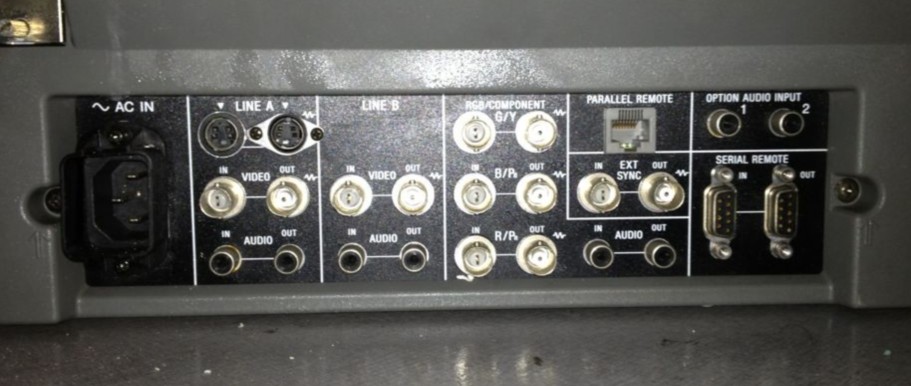Retro video game consoles are well known for their pixelated and sometimes fuzzy graphics. But that has less to do with the actual hardware itself, and more to do with the consumer displays of the era. Consumer televisions did not offer much in the way of decent quality inputs, and most people played their video games from a lowly RF connection back in the day.
However, retro consoles are quite capable of arcade quality graphics. Many of them are output RGB, a high quality video signal that looks amazing but is generally only supported by European TVs or professional monitors.
There are also many alternatives that look much better than RF or composite which are cheap and easy to implement in your gaming setup. Depending on how much money you want to spend and your monitor of choice, of course.
Video display options
Here are the most common types of video outputs for most consoles:
RF (radio frequency)

This is the most common video output and almost all retro consoles come equipped with an RF modulator. RF combines video and audio into a single coaxial cable, which can be connected the ANT inputs on televisions.
Since the video and audio are carried in one cable the chroma signal is combined with the luma signal , the actual video quality leaves much to be desired. Additionally, most RF modulators are of inferior quality. Consoles connected in this manner will display a picture that is very noisy with a lot of dot crawl.
RF cannot carry a stereo signal so you are limited to mono sound. If you have a poor quality cable or bad RF modulator you will likely experience audio humming noise as well.
Basically, RF is an antiquated technology that should be avoided at all costs. Most consoles are capable of better video output and even If you have an RF only console such as the NES top loader or the Atari there are options to modify them to output better video quality.
*Fun fact: RF really is a radio transmission and its actually possible for RF equipped TVs to pick up a signal sent from a RF out on a console without a cable connected. Obviously the signal will be degraded on the receiving device but this could be considered “wireless video”.
Composite (CVBS)

The yellow/red/white RCA cables that come with most video game consoles and A/V equipment are bog standard and have become synonymous with composite video. Composite video separates video out from the audio but it is still a combined signal, with luma/chroma and blanking/sync all carried over a single cable.
Composite is a slight improvement over RF (about 10-20%) and many newer TVs come equipped with good quality comb filters, which can help to clean up the signal even further and reduce discoloration/dot crawl quite a bit.
Overall, even the best display produces a rather soft picture with composite video, and sharpness/detail are mediocre at best. And while there are some games that have specially coded effects (such as the famous waterfall effect in sonic the hedgehog 2, for instance) when displayed in composite, the disadvantages far outweigh the occasional benefits.
Y/C VIDEO (SEPERATED VIDEO)

S-video is standard that separates the luma and chroma (y and c, or black/white and color respectively) of a video signal in to 2 pins for a much improved image. S video goes through much less processing than composite, and generally produces a much cleaner and sharper image.
The problem with svideo is that it is basically a middle ground. It doesn’t look quite as good as rgb or component, and many newer displays have ditched svideo in favor of digital or component inputs. For certain consoles svideo output may be the highest quality output, but this scenario is rare.
Svideo was very common in the US but the most of the rest of the world used RGB/scart. Most consoles from PAL regions do not output svideo, and instead output RGB. Some European displays can display svideo over scart but it is rare.
RGB Scart

RGB is form of video that is carried over 3 separate lines to produce a very clean and crisp image. Images displayed over RGB are very sharp, have no dot crawl and have highly accurate and vibrant coloring.
For consoles the typical method of displaying RGB is via a scart connector. The scart cable carries the red, green, blue, and sync (typically composite sync) into the display. Many consoles are capable of outputting RGB with little or no modification. If you can acquire a display that supports it, RGB is the way to go. If you are in the US you will likely need a broadcast monitor or a tv that is modified to support RGB.
* Note: is actually a form of RGB video, but it is displayed in a different manner. VGA requires separate horizontal and vertical sync signals, whereas the TV/broadcast standard has the H/V sync combined (RGBS) into a single line.
YPBPR (Component Video)

While most TVs/consoles in Europe have RGB, the US has component video as a standard. Component is video carried over 3 lines, just as in RGB. The difference is that the Y line carries the luma/sync, and the other 2 lines carry color difference information. Component video looks nearly identical to RGB, and can be sent over a scart cable.
Component video is actually a highly flexible analog video standard, and is similar in quality to RGB, with the benefit of being able to support 720p/1080p. Many 6th gen and older consoles will output component in 480p or higher resolution. However, the current generation of consoles are completely digital and only have hdmi outputs.
Most game consoles that are 5th gen or older do not output component video natively. RGB can be converted to component at the loss of a very small amount of color detail, so if you have a consumer display that has component inputs then this may be a better option than doing a full RGB mod to your television set.
VGA

VGA is a form of RGB video that is common in the PC world. The difference being that is has separate horizontal and vertical (RGBHV) sync lines. VGA is capable of very high resolutions, however most consoles that support VGA output something like a 640x480p signal. VGA is similar to component and is a good alternative if your console supports it, since you can generally get old computer monitors for next to nothing.
VGA does not support interlaced (480i, 576i, etc) resolutions.

